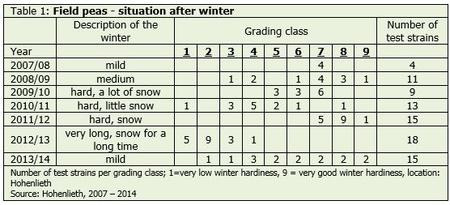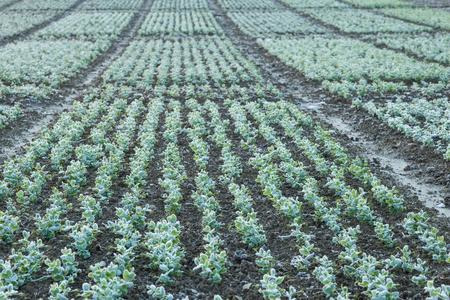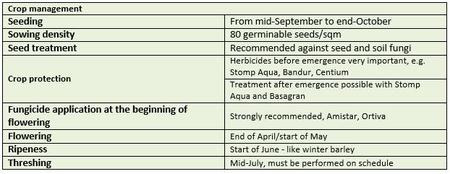International
An interesting alternative to spring peas
The growing of frost tolerant field peas is becoming more attractive, as new varieties promise greater cultivation reliability.
New possibilities
Climate change will most likely lead to an increase in extreme weather such as periods of heat and draught. Therefore, in the future the performance of the summer seeds could be more impaired than the winter seeds, which, due to the longer vegetation period have a better chance for regeneration and compensation.
The integration of the ecological priority zones into the agricultural crop planning and into the national protein strategy of the Federal Government makes the field pea interesting for farmers. Meanwhile, long-term experience has been gained with growing and there are established breeding activities in France.
Crop development
Field peas are sown from end of September to the end of October. With a shoot length of 5 cm before onset of winter, the peas covering part of the soil and begin rooting. This growth in the winter months can prevent erosion and wash out. In spring, the peas quickly begin growing, as they can use the winter moisture, sun’s rays and rising temperatures straight away for establishment. In comparison to spring peas, this means a development advantage of approx. 3 weeks.
Flowering occurs considerably earlier in field peas than in spring peas and therefore prevents a possible pre-summer drought. Therefore, on sites which suffer from drought in summer, the field pea can present a real alternative to the spring variety. At the start of flowering of the winter variety, there are still few flying insects relatively little, resulting in a lower infestation rate by pea aphids and pea moths. Particularly positive in practice is early clearance of the plots, which usually coincides with the harvest of the winter barley.
The of field pea harvest can, depending on site and vegetation profile, be equivalent to that of the spring peas or even surpass it.
Field and spring peas differ in the organisation of their yield structures. Field peas form, in contrast to spring peas, at least two or more full-value side shoots, which in the same way contribute to the yield. The TGW of field peas is considerably below the weight of the spring varieties. This results in a lower seed requirement per hectare.
Winter hardiness in the test
As mentioned earlier, field peas are actively bred in France. NPZ has already been testing field peas for eight years on several sites in Germany. Here, the focus is particularly on winter hardiness and yield.
To measure the overwintering performance of the breeding strains, the plots are assessed both before and after winter. Table 1 shows the full spectrum of grades of the tested varieties and breeding strains at the time point after winter. A grade of more than 6 means sufficient to good overwintering. It is clear that the variety characteristics and the severity of winter both influence the winter hardiness attribute. The lack of covering snow in winter 2010 /11 and the long winter 2012/13 occurring at a time when the plants were barely hardened off left their marks. Nearly every year, a number of the candidates have survived winter without greater damages.
To be protected against frost in winter, all winter crops need to go through a process of hardening off, which begins at temperatures below 10 °C and takes several weeks. Rising temperatures cancel this frost tolerance again. According to the French results, maximum frost tolerance for the variety JAMES is at -18 °C.
The approval of the variety JAMES in the year 2009 presented a clear improvement in winter hardiness and was a milestone for field pea breeding. This variant could also prove itself under German winter conditions. JAMES still is important as standard for the attribute winter hardiness. Table 2 shows the results of winter hardiness and yield from the last three years of established field pea varieties and new breeding strains from the breeding garden in Hohenlieth, Schleswig-Holstein.
The results of the trials show that the new varieties and strains have no better but a much more stable winter hardiness than JAMES. The new breeding strain DEXTER is a hopeful follow-up candidate not only for France. The French variety classification assesses JAMES and the variety Gangster in winter hardiness best with grade 6, Comanche a grade down and the variety Indiana with grade 3 worst.
Outlook
Besides the required winter hardiness, there is a sign that breeding measures improve yield and agronomic characteristics, such as lodging resistance (strain Jasper). As a result of breeding work, further varieties besides JAMES are now available, which demonstrate good winter hardiness and good agronomic characteristics.
Crop management
Winter annuals are regularly colonised by fungi, which can then hugely develop in constantly damp weather conditions in spring and early summer. This clarifies that a fungicidal treatment should be an important part of the production technique in spring, if there is strong initial colonisation. The experiences gained allow us to create a preliminary growing sheet (see Table below).
Silke Hadenfeldt, Dr. Olaf Sass,
Norddeutsche Pflanzenzucht Hans-Georg Lembke KG
As of: 29.01.2015
Picture credits: Norddeutsche Pflanzenzucht Hans-Georg Lembke KG






